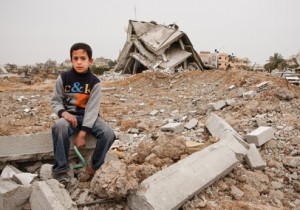 The House of Representatives, the State Department, and various pro-Israel organizations in Washington have all issued statements expressing support for Israel’s recent actions in the Gaza Strip and reaffirmed Israel’s right to act in “self-defense.”
The House of Representatives, the State Department, and various pro-Israel organizations in Washington have all issued statements expressing support for Israel’s recent actions in the Gaza Strip and reaffirmed Israel’s right to act in “self-defense.”
Indeed, Israel’s right to self-defense is important to remember and every missile fired from Gaza is one too many. But while Israel’s right to defend itself against Hamas’ aggression is reaffirmed on a daily, if not hourly basis, another incontrovertible fact gets little mention or discussion.
Over the past ten years of on-again-off-again fighting, the ratio of Palestinian to Israeli deaths has been dramatically one-sided. According to the Israeli NGO B’Tselem, 4,858 Palestinians were killed by Israeli security services in between the outbreak of the second intifada in September 2000 and the beginning of operation “Cast Lead” in December 2008. During this period 1,063 Israelis were killed by Palestinian attacks, resulting in approximately 4.5 Palestinian deaths for every Israeli casualty.
During Operation Cast Lead, in less than one month of fighting, 1,397 Palestinians were killed by Israeli security forces and nine Israelis were killed by Palestinian attacks. The ratio grew to 155 Palestinian deaths for each Israeli casualty.
In the past six days of violence the ratio has remained one-sided. Reports from Gaza indicate an overall death toll reaching 100. Three Israelis have died. The current ratio of Palestinian to Israeli casualties is 33.3 to one.
Obviously the numbers don’t tell the full story of the conflict. The numbers of civilian vs. military casualties matter as do troubling reports of Hamas using civilians as human shields. And both parties in the conflict receive little assistance from regional partners in imposing a meaningful peace process.
But the numbers also tell an undeniable truth and raise an important question. Maintaining Israel’s security is coming at a vastly higher cost in Palestinian deaths. At what point does Israel’s response become disproportionate?
The 33-to-one ratio of Palestinian to Israeli deaths in the past week means that Israel’s most staunch defenders, both in Israel and abroad, accept the disproportionate loss of life as an acceptable, if not wholly necessary, cost.
What does the devaluation of Palestinian life mean for the future of the peace process? What does it mean for Israel’s future capability to live at peace with its neighbors? What does it say about Israel’s future as a liberal democracy if its security relies on killing a vastly disproportionate number of Palestinians in every recent conflict with Palestinian militants?
A statement from J Street, Washington’s “Pro-Israel, Pro-peace” lobby, reveals a growing awareness of the unsustainable direction of Israel’s policies.
Yesterday, while emphasizing Israel’s “right and obligation to defend itself against rocket fire”, J Street urged a halt to the violence. “Today, rockets are more numerous and powerful. Israel is more isolated in its region and more ostracized around the world.”
The statement continued:
Military action may stop the rockets for a while at a cost of hundreds or even thousands injured or dead. But military force alone is inadequate as a response to the broader strategic challenge Israel faces. Only a political resolution to the century-old conflict with the Palestinians resulting in two states living side by side can end the conflict.





